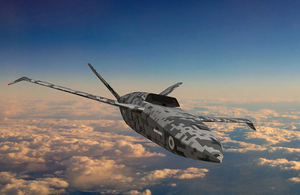
The Eurofighter Typhoon is a European multinational twin-engine, supersonic, canard delta wing, multirole fighter. The Typhoon was designed originally as an air-superiority fighter and is manufactured by a consortium of Airbus, BAE Systems and Leonardo that conducts the majority of the project through a joint holding company, Eurofighter Jagdflugzeug GmbH. The NATO Eurofighter and Tornado Management Agency, representing the UK, Germany, Italy and Spain, manages the project and is the prime customer.

The Future Combat Air System (FCAS), is a European combat system of systems under development by Dassault Aviation, Airbus and Indra Sistemas. The FCAS will consist of a Next-Generation Weapon System (NGWS) as well as other air assets in the future operational battlespace. The NGWS's components will be remote carrier vehicles as well as a New Generation Fighter (NGF)—a planned sixth-generation jet fighter—that will possibly supersede France's Rafale and Germany and Spain's Typhoons.

The Eurofighter Typhoon is in service with nine nations: United Kingdom, Germany, Italy, Spain, Saudi Arabia, Oman, Qatar, Kuwait, and Austria, with orders for all nine customers still pending as of September 2017. The aircraft has, as of 2016, been provided in a basic air-defense form and has been upgraded to newer production standards which include internal IRST, air-to-ground precision strike capability, and HMSS helmets. Most of the major systems including the CAPTOR radar and the Defence Aids Sub-System (DASS) are expected to be improved and updated over time, with the radar being updated to an AESA, being the CAPTOR-E/CAESAR, of which the Kuwait Air Force will be the inaugural operator, with first deliveries of their 28 new-built aircraft to commence in 2019.

The planning for the future of the Royal Air Force involves supporting ongoing British military operations and the introduction of new aircraft types including unmanned aerial vehicles and the BAE Systems Tempest sixth-generation fighter in the 2030s. Priorities include greater focus on network enabled capability and mixing crewed fighter jets with UAVs and swarming drones. The new initiative will focus on increasing interoperability with members of NATO and becoming carbon net-zero, with strategies such as using sustainable aviation fuels in aircraft.
A sixth-generation fighter is a conceptualized class of jet fighter aircraft design more advanced than the fifth-generation jet fighters that are currently in service and development. Several countries have announced the development of a national sixth-generation aircraft program, including China, the United States, and Russia. Other countries have joined collaborative multinational projects, such as Japan, Italy, and the United Kingdom with Global Combat Air Programme, and France, Germany, and Spain with FCAS in order to spread development and procurement costs. The first sixth-generation fighters are expected to enter service in the 2030s.
The Indian Air Force has been undergoing a modernization program to replace and upgrade outdated equipment since the late 1990s to meet modern standards. For that reason, it has started procuring and developing aircraft, weapons, associated technologies, and infrastructures. Some of these programs date back to the late 1980s. The primary focus of current modernization and upgrades is to replace aircraft purchased from the Soviet Union that currently form the backbone of the air force.
Airbus Defence and Space is a division of Airbus SE. Formed in 2014 in the restructuring of European Aeronautic Defence and Space (EADS), Airbus SE comprises the former Airbus Military, Astrium, and Cassidian divisions. Contributing 21% of Airbus revenues in 2016, it is the second largest space company in the world.

The AVIC Dark Sword is a stealthy supersonic unmanned combat aerial vehicle from the People's Republic of China. It is being developed by the Aviation Industry Corporation of China's Shenyang Aircraft Design Institute for the air superiority or deep strike roles. Use as an autonomous wingman for manned aircraft may also be a goal.
The Future Offensive Air System was a study to replace the Royal Air Force's strike capability, at the time provided by the Tornado GR4. Initial operational capability was expected around 2017. The FOAS was cancelled in June 2005 and was replaced by the Deep and Persistent Offensive Capability (DPOC) requirement, which was itself cancelled in the 2010 Strategic Defence and Security Review.

The BAE Systems Tempest is a proposed sixth-generation fighter aircraft that is under development in the United Kingdom for the Royal Air Force (RAF). The aircraft is intended to enter service from 2035, gradually replacing the Eurofighter Typhoon. It is being developed as part of the Future Combat Air System (FCAS) programme by a consortium known as Team Tempest, which includes the Ministry of Defence, BAE Systems, Rolls-Royce, the UK subsidiary of Leonardo, and MBDA UK. £2 billion is planned to be spent by the British government on the initial phase of the project up to 2025.

The Kratos XQ-58 Valkyrie is an experimental stealth unmanned combat aerial vehicle (UCAV) designed and built by Kratos Defense & Security Solutions for the United States Air Force's Low Cost Attritable Strike Demonstrator (LCASD) program, under the USAF Research Laboratory's Low Cost Attritable Aircraft Technology (LCAAT) project portfolio. It was initially designated the XQ-222. The Valkyrie completed its first flight on 5 March 2019 at Yuma Proving Ground, Arizona.
Eurofighter Typhoon procurement is the planned selection and purchase of the Eurofighter Typhoon jet fighter by various countries.

The Sukhoi S-70 Okhotnik-B, also referred to as Hunter-B, is a Russian heavy unmanned combat aerial vehicle (UCAV) that was being developed during the 2010s by Sukhoi and Russian Aircraft Corporation MiG. Several prototypes underwent flight testing in 2019–2023 and, as of January 2024, it was projected that production could begin as early as the second half of 2024.

The Boeing MQ-28 Ghost Bat, previously known as the Boeing Airpower Teaming System (ATS), is a stealth, multirole, unmanned combat aerial vehicle developed by Boeing Australia for the Royal Australian Air Force (RAAF). It is designed as a force multiplier aircraft capable of flying alongside crewed aircraft for support as part of an integrated system including space-based capabilities, and performing autonomous missions independently using artificial intelligence.

The Spirit Mosquito was an unmanned combat aerial vehicle (UCAV) technology demonstrator in development by Team Mosquito in the United Kingdom. In January 2021, the aircraft was chosen as a technology demonstrator for the Royal Air Force's Lightweight Affordable Novel Combat Aircraft (LANCA) concept which was first conceptualised in 2015 by the RAF Rapid Capabilities Office.
The HAL Combat Air Teaming System (CATS) is an Indian unmanned and manned combat aircraft air teaming system being developed by Hindustan Aeronautics Limited (HAL). The system will consist of a manned fighter aircraft acting as "mothership" of the system and a set of swarming UAVs and UCAVs governed by the mothership aircraft. A twin-seated HAL Tejas is likely to be the mothership aircraft. Various other sub components of the system are currently under development and will be jointly produced by HAL, National Aerospace Laboratories (NAL), Defence Research and Development Organisation (DRDO) and Newspace Research & Technologies.

HAL CATS Warrior is a low observable unmanned combat aerial vehicle and a loyal wingman developed by the Aircraft Research and Design Centre (ARDC) under the state-owned Hindustan Aeronautics Limited (HAL). The aircraft is a part of the Combat Air Teaming System (CATS) programme undertaken by a Public Private Partnership (PPP) between the HAL and NewSpace Research and Technologies (NRT), an Indian private startup. In Aero India 2021, a scaled-down mock-up was presented for the first time.

The Global Combat Air Programme is a multinational initiative led by the United Kingdom, Japan, Italy to jointly develop a sixth-generation stealth fighter. The programme aims to replace the Eurofighter Typhoon in service with the Royal Air Force (RAF) and Italian Air Force, and the Mitsubishi F-2 in service with the Japan Air Self-Defense Force.

Collaborative combat aircraft (CCA) is a US program for unmanned combat air vehicles (UCAVs) that is considered broadly equivalent to a loyal wingman. CCAs are intended to operate in collaborative teams with the next generation of manned combat aircraft, including sixth-generation fighters and bombers such as the Northrop Grumman B-21 Raider. Unlike the conventional UCAVs, the CCA incorporates artificial intelligence (AI), denoted an "autonomy package", increasing its survivability on the battlefield. It is still expected to cost much less than a manned aircraft with similar capabilities. The US Air Force plans to spend more than $8.9 billion on its CCA programs from fiscal years 2025 to 2029, with an additional $661 million planned for fiscal year 2024. The success of the CCA program may lessen the need for additional manned squadrons.
A loyal wingman is a proposed type of unmanned combat air vehicle (UCAV) which incorporates artificial intelligence (AI) and is capable of collaborating with the next generation of crewed combat aircraft, including sixth-generation fighters and bombers such as the Northrop Grumman B-21 Raider. Also unlike the conventional UCAV, the loyal wingman[sic] is expected to be capable of surviving on the battlefield but to be significantly lower-cost than a crewed aircraft with similar capabilities. In the US, the concept is known as the collaborative combat aircraft (CCA).












